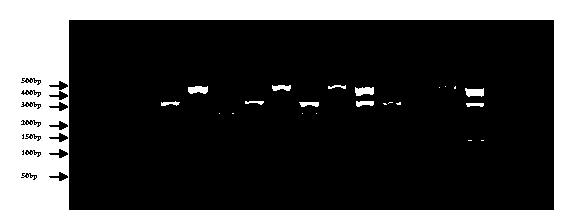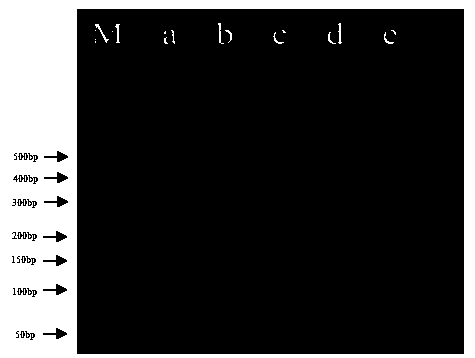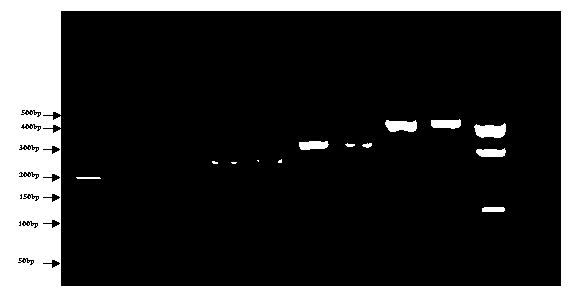Multiplex-PCR (Polymerase Chain Reaction) detection primer group and kit for various duck-derived pathogenic bacteria
A detection kit and pathogenic bacteria technology, which is applied in the direction of recombinant DNA technology, microbial measurement/inspection, and resistance to vector-borne diseases, etc. It can solve the problems of long detection cycle, cumbersome operation, and inability to detect in large quantities.
- Summary
- Abstract
- Description
- Claims
- Application Information
AI Technical Summary
Problems solved by technology
Method used
Image
Examples
Embodiment 1
[0035] Example 1 Primer Design and Primer Specificity Detection
[0036] This embodiment utilizes the different serotypes of R. anatipestifer to be determined by the applicant and submitted to GenBank wxya The sequence of the gene (GenBank accession numbers), and other bacteria published on GenBank, such as Escherichia coli, Streptococcus, Salmonella, etc. wxya The genes were compared, and the regions with large sequence differences were selected to design primers for the detection of R. anatipestifer. The primer pair was RA rpoB-P1 (SEQ ID NO: 1) and RArpoB-P2 (SEQ ID NO: 2 ).
[0037] This embodiment selects the housekeeping gene of Escherichia coli phoA The gene was used as the target gene for the detection of Escherichia coli in ducks. for different bacteria that have been published phoA The primers were redesigned according to gene sequence alignment, and the primer pair was E. coli phoA-P1 (SEQ ID NO: 3) and E. coli phoA-P2 (SEQ ID NO: 4).
[0038] In this examp...
Embodiment 2
[0050] Example 2 Establishment of Multiplex PCR Detection Kit for Duck-derived Pathogenic Bacteria
[0051] Prepare duck-derived pathogenic bacteria multiplex PCR detection kit according to the following composition:
[0052] Contains 10×PCR reaction buffer (100mM Tris-HCl (pH8.3), 500mM KCl, 15mM MgCl 2 ), DNA polymerase (5units / μL), dNTP (2.5mM), and 4 pairs of primers (10uM) are as follows:
[0053] SEQ ID NO: 1: 5'-TGCCCAAGCGAATGTGGAGC-3';
[0054] SEQ ID NO: 2: 5'-ACCGGAAATCTGGTTTGGCG-3';
[0055] SEQ ID NO: 3: 5'-CGATAAGCCCGCAGTCACCT-3';
[0056] SEQ ID NO: 4: 5'-GACCAGCGTGTTACCCTCCT-3';
[0057] SEQ ID NO: 5: 5'-TACCAGAAAGGGACGGCTAA-3';
[0058] SEQ ID NO: 6: 5'-CGTTTACGGCGGCGTGGACTACC-3';
[0059] SEQ ID NO: 7: 5'-TGGGTAACGCATGAAGAGGG-3';
[0060] SEQ ID NO: 8: 5'-GGGTCAAGGCTGAGGAAGGT-3'.
[0061] The present invention optimizes the above conditions, and finally determines the reaction system of the kit as follows: 10×PCR reaction buffer 5 μL, DNA polymerase 0....
Embodiment 3
[0065] The specificity of the described multiplex PCR detection kit of embodiment 3
[0066] Prepare 107 cfu / mL of Reeserella anatipestifer (serotype 1), Escherichia coli (ATCC8099), Streptococcus (CVCC556), Salmonella typhimurium, Pasteurella avium, Staphylococcus aureus, Pseudomonas aeruginosa and Mycoplasma, etc. 18 strains of bacteria, the DNA templates of 18 strains of bacteria were extracted by boiling method. Single strain DNA, two-two mixed strain DNA, three-three mixed strain DNA and four-strain mixed strain DNA extracted from 4 strains of R. anatipestifer, Escherichia coli, streptococcus and Salmonella were used as templates, Pasteurella avian, golden yellow Single-strain DNA extracted from four strains of Staphylococcus aeruginosa, Pseudomonas aeruginosa and Mycoplasma was used as a template, and a PCR reaction was performed under the optimized PCR conditions described in Example 2 to determine the specificity of the multiplex PCR reaction. The PCR reaction product...
PUM
 Login to View More
Login to View More Abstract
Description
Claims
Application Information
 Login to View More
Login to View More - R&D
- Intellectual Property
- Life Sciences
- Materials
- Tech Scout
- Unparalleled Data Quality
- Higher Quality Content
- 60% Fewer Hallucinations
Browse by: Latest US Patents, China's latest patents, Technical Efficacy Thesaurus, Application Domain, Technology Topic, Popular Technical Reports.
© 2025 PatSnap. All rights reserved.Legal|Privacy policy|Modern Slavery Act Transparency Statement|Sitemap|About US| Contact US: help@patsnap.com



